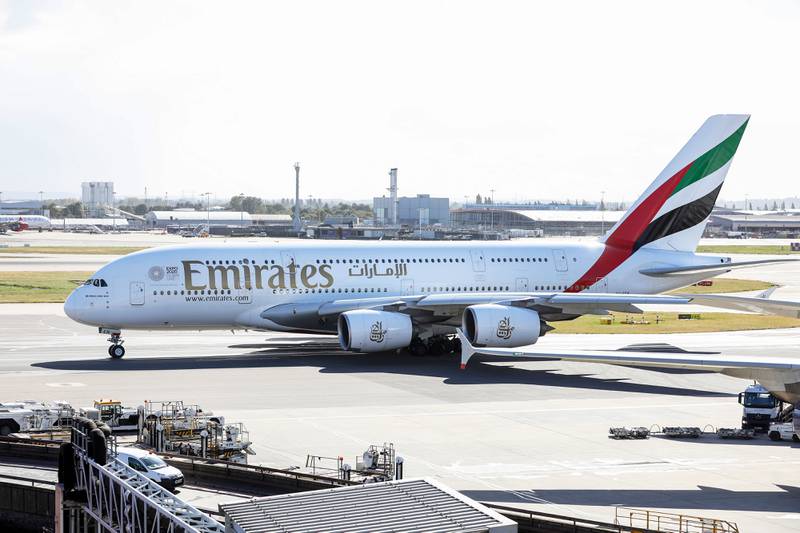Emirates makes world’s top 10 airlines by passenger traffic and flydubai climbs 38 places
06 September, 2022

Emirates remains one of the world’s top 10 airlines by passenger traffic, carrying more than 19 million passengers last year.
The Dubai airline ranks seventh as aviation analytics company Cirium revealed its 2021 World Airline Passenger Rankings.
Emirates flew 19.6 million people around the world last year. That's an increase of 199 per cent compared to passenger levels in 2020, when travel disruption because of the Covid-19 pandemic was at its highest.
The rankings are dominated by US carriers, with American Airlines taking the top spot, followed by Delta, United and Southwest as measured in revenue per kilometres. This is calculated by multiplying the number of revenue paying passengers aboard an aircraft by the distance the aircraft travelled. Low-cost carrier Ryanair ranks in fifth, while China Southern slipped to take one spot ahead of Emirates.
Based on tracking more than 600 operators via Cirium's airline database, the ranking shows that despite an improvement since 2020, world traffic ended 2021 down by 57 per cent against its pre-pandemic peak with a global figure of 2.3 billion.
Compared to passenger numbers in 2019, Emirates recorded a drop of 65 per cent from its 2019 peak.
Top 10 World Airline Passenger Rankings for 2021
- American Airlines
- Delta Air Lines
- United Airlines
- Southwest Airlines
- Ryanair
- China Southern
- Emirates Airline
- Qatar Airways
- China Eastern Airlines
- Turkish Airlines
Qatar Airways also retained its position in the top 10 airlines by passenger traffic. The gap between Emirates and the Doha airline narrowed in 2021, with the latter ranking just behind Dubai’s largest carrier in eighth place. In 2019, the airline listed six places behind Emirates.
China Eastern Airlines and Turkish Airlines round out the top 10 ranking.
Despite slipping from fourth position to seventh, Emirates ranking in the world's top 10 list is impressive given that the impact of the Covid-19 pandemic has been worst in the Middle East.
“The main standout was among Middle-Eastern carriers who saw 80 per cent of traffic disappear from their long-haul, and often highly connected networks. Elsewhere traffic declines were grouped around the 60-70 per cent mark,” says Kevin O’Toole, chief strategy officer at Cirium.
Budget airlines climb up the rankings
A post-Covid trend towards domestic and short-haul travel combined with a slower recovery of business travel has resulted in low-cost airlines rise up the ranks in 2021.
Budget airlines accounted for a third of all passengers in this year's report, with the world's largest low-cost carrier Southwest leading the charge to rank fourth globally.
Ryanair also kept pace with the big US airlines, ranking in the world’s top five airlines by passenger numbers, and as the largest airline in Europe by passenger traffic.
Wizz Air broke into the top 20 for the first time, while low-cost airline flydubai climbed 38 places from its position in 2019, to rank in 63rd place.
The Cirium rankings of the world’s leading airlines reveal how the Covid-19 pandemic has dramatically altered the aviation landscape over the past two years. After the collapse of passenger traffic in 2020, it was somewhat inevitable passenger numbers would increase in 2021.
Covid-19 recovery remains fragile
From a high-point of nearly 4.7 billion journeys recorded in 2019, passenger numbers fell by more than 60 per cent in 2020. At the worst point in April, the airline industry was recording the loss of close to 90 per cent of travellers, according to Cirium data.
And while momentum is now building, volumes remain far from pre-pandemic levels.
Even after a 29 per cent hike in 2021, passenger numbers ended the year at 2.3 billion, still only about half of their pre-Covid levels.
And while recovery is now under way, the impact of the pandemic is likely to remain for several years.
“Despite the occasional glimmers of optimism, it is worth remembering that even if traffic levels do return to pre-pandemic levels over the next couple of years or so, that has wiped out half a decade of passenger growth,” says O'Toole.
Spiralling fuel prices, the prospect of an economic downturn and Russia’s invasion of Ukraine and related sanctions could also impact the industry's recovery in a post-Covid world.
Source: www.thenationalnews.com
